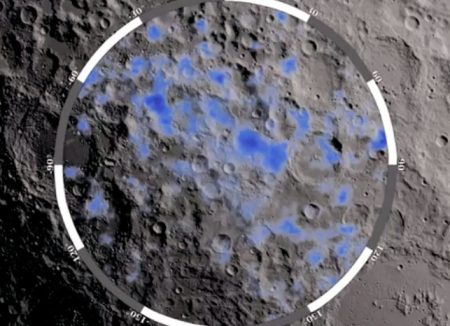June 3, 2017 – The lunar surface a mere 5 degrees from the Moon’s south pole appears to have surface water ice. It’s not like that at the Moon’s north pole so this must be an anomaly rather than a location feature consistent with the extremes of North and South. Somehow water got deposited on the Moon and has managed to stay there for probably billions of years.
The area near the south pole affected when viewed by the Lunar Reconnaissance Orbiter, a spacecraft that has been circling the Moon since 2009, are described as cold traps. They don’t receive direct sunlight and surface temperatures are -163 Celsius (-260 Fahrenheit) degrees. The presence of water is deduced by the surface reflectivity of these locations which appear far brighter than their surroundings.
So how did the water get there?
There are two likely sources. The first is icy comets and asteroids that collided with the Moon throughout its geologic history. Most of these collisions go back to early in the Solar System’s development.
The second likely source is the solar wind which in reacting with the Moon’s lunar surface chemistry may have produced layers of icy frost. The solar wind hypothesis would mean that the detected water is much younger.
Scientists favour the former over the latter. Why? Because the former would explain the location specific nature of what is being observed, whereas the latter should yield evidence of frost in many other locations including the northern pole.
Interestingly, Mercury also has frozen ice deposits in cold traps found in areas where sunlight doesn’t reach both at its south and north poles. The total volume of water detected on Mercury is 400 times greater than what we have discovered on our Moon.
How does finding water ice on the Moon explain how Earth got its oceans?
During the early Solar System, a period of bombardment by icy comets and asteroids could have delivered water to Earth in significant quantity to create the oceans we see today. The only other source would have been outgassing from beneath the planet’s crust. Possibly both contributed to what we see today, a misnamed planet that is more ocean than Earth and yet called the latter.
The latest study which appears in the journal Icarus is consistent with data previously reported from a 2015 paper. States Matt Siegler, a researcher with the Planetary Science Institute in Dallas, “what has always been intriguing about the Moon is that we expect to find ice wherever the temperatures are cold enough for ice, but that’s not quite what we see.” Scientists continue to speculate that the Moon may harbour a large volume of subsurface ice that is as old as the beginning of the formation of the Earth-Moon system.
















